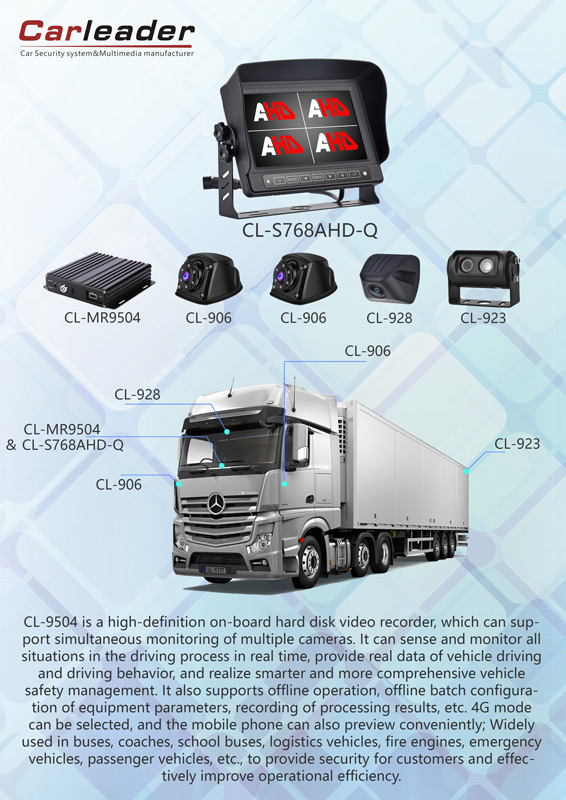Development Status and Trend of Vehicle Monitoring System
2022-11-12
1. composition of vehicle monitoring system
The vehicle-mounted monitoring system generally consists of front-end vehicle-mounted hard disk video recorder, vehicle-mounted special camera, vehicle-mounted LCD screen, alarm button and status display terminal, and supporting cables and wires. A vehicle will be equipped with 4 to 8 on-board cameras to cover the internal and external environment of the vehicle, collect and encode the real-time running images, store the video data in the hard disk under shock protection, receive satellite positioning signals through the built-in GPS/ Beidou module, and use the built-in 3G/4G wireless network communication module to transmit the collected video image data to the mobile video monitoring center platform in real time, and locate the vehicle's position on the map. The collected vehicle operation data is uploaded to the operation platform, which realizes the supervision functions of remote vehicle video preview, remote video playback, real-time vehicle positioning, track playback, etc.
2. Characteristics of on-board monitoring system
Compared with the application of fixed-point video monitoring equipment, the technology adopted by vehicle-mounted monitoring terminal is more complicated.Efficient vehicle power management function. The built-in power supply of the vehicle-mounted hard disk video recorder needs to conform to ISO-7637-II, GB/T21437 and other vehicle-mounted power supply standards, and has a wide voltage input of 8V~36V and a high-power regulated power output, so as to adapt to different types of 12V and 24V vehicles, and can adapt to the transient low voltage when the vehicle starts and the transient high voltage of hundreds of volts when the load is dropped. Provide effective protection for output voltage, and avoid equipment damage or even fire caused by short circuit of audio and video extension cable. At the same time, it has the characteristics of ultra-low power consumption, which can avoid excessive consumption of vehicle battery when the equipment is in standby.
Reliable hard disk damping technology. Due to the intense vibration in the vehicle driving process, strong hard disk damping technology is needed to ensure that the video data can be written into the hard disk stably and completely, and play a good role in protecting the hard disk, delaying its service life. At the same time, it is necessary for the vehicle-mounted camera to have the image shake-removing function, so as to avoid the blurring or smearing of the monitoring picture caused by vibration.
Totally enclosed enclosure and fanless heat dissipation technology. When the vehicle is running, it will be in the dust and water vapor environment for a long time, so it is required that the equipment must have good tightness to avoid dust and water vapor from entering the equipment and causing equipment damage. At the same time, because the chip and hard disk generate a lot of heat when they work, they can't dissipate heat through the fan. They need to rely on a good structural design, which can lead out the heat inside the equipment to ensure the normal operation of the equipment.
Dedicated aviation head connection. Aviation joints can effectively ensure the reliability of connection and the integrity of signal transmission, avoid loosening or falling off of joints caused by vehicle vibration, and facilitate wiring and installation on the vehicle. For network NVR equipment, POE technology can be used to superimpose the power supply signal on the network cable, which can reduce the number of connecting cables and improve the connection reliability.
Backup power supply technology. When a vehicle encounters a collision accident, the battery of the vehicle often cannot supply power to the equipment, so it is necessary to adopt the backup power supply technology to prevent data loss caused by sudden power failure. The backup pow technology can write that video data stored in the memory at the moment of pow failure into the hard disk, thus avoiding the loss of the key video at this moment.
Adaptive technology of wireless network transmission. Because the coverage signal strength of different areas of wireless communication network is different, vehicle-mounted DVR needs to increase the video coding rate when the signal is strong according to the signal strength of wireless network, and reduce the coding rate and frame rate when the signal is weak according to the current network bandwidth, so as to ensure the fluency of the remote preview picture of the central platform.
Replaceable network module design. With modular design, the original equipment can be upgraded from 3G system to 4G system on the spot, which is convenient for upgrading the equipment wireless communication network system and reduces the cost pressure of users when upgrading the network system.
3. Industrial application
As industry users pay more and more attention to vehicle monitoring system, vehicle monitoring gradually develops from a single video monitoring application to a system scheme that is deeply combined with the corresponding industry. The Ministry of Communications has successively issued relevant standards and regulations such as Technical Requirements for Vehicle Terminal of Satellite Positioning System for Road Transport Vehicles, Vehicle Intelligent Service Terminal for Urban Public Buses and Trams, Taxi Service Management Information System-Special Equipment for Operation, Regulations on School Bus Safety Management, etc., which have an urgent demand for vehicle monitoring system. With the rapid development of high-definition, intelligence and 4G network technology, vehicle monitoring system has become an important part of intelligent transportation. With the rapid growth of public travel demand, Driven by the rapid development of intelligent transportation, the vehicle-mounted monitoring system will be widely popularized, have a greater application prospect, and can also bring better economic and social benefits of enterprises.





